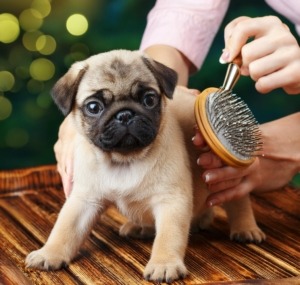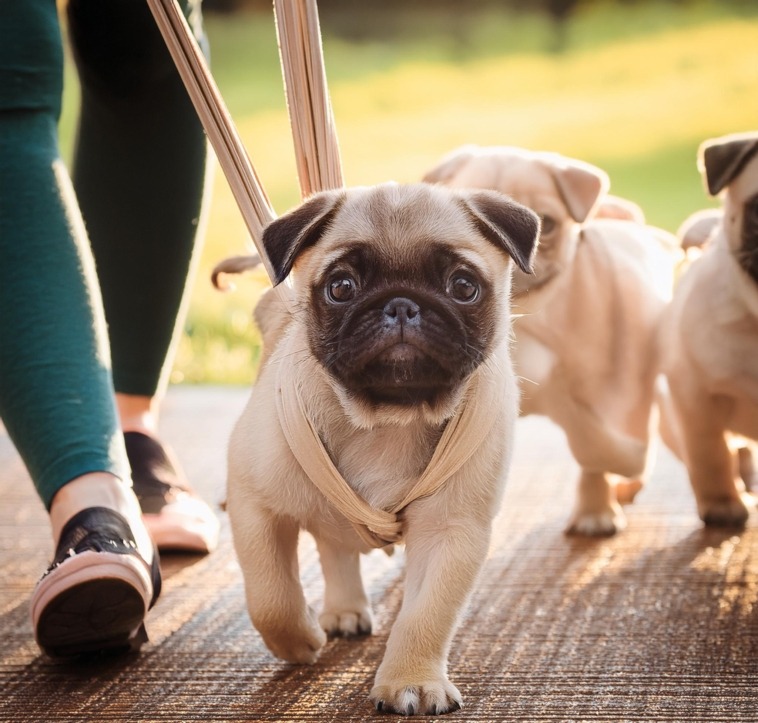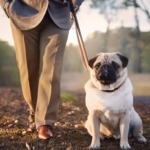Last updated on October 24th, 2024
Here’s an overview:
Characteristics of Pug Puppies
Preparing Your Home for a Pug Puppy
Crate Training and Housebreaking
Grooming Advice for New Pug Owners
Understanding Pug-Specific Health & Caring pug
Mental Stimulation and Enrichment
How to Build a Strong Relationship with Your Pug Puppy
Final Thoughts & Long-term Care Tips
Characteristics of Pug Puppies
- Lively: Pug Puppy enjoys games and interactive activities.
- Faithful: Forms strong bonds with their owners.
When caring for a baby pug, you need to understand that it can be a little cranky at times.
Preparing Your Home for a Pug Puppy
Preparing your home for the arrival of a new puppy needs some preparations.
- Create a Safe Space: Set up an area where they can be confined when you are not in the room. Get a puppy pen or use baby gates.
- Remove Hazards: Make sure all electrical cords have been hidden, there are no small objects around and keep toxic plants out of reach.
- Stock Up on Supplies:
- Food and water bowls
- Puppy food
- Chew toys and teethers
Set Up a Sleeping Area: Provide your dog with its own bed or crate to sleep in.
Arrange Vet Visits: Plan out initial vet appointments as well as vaccination dates.
Puppy-Proof Outdoor Areas: Secure fences and remove any dangerous items outside the house.
Choosing the Right Pug Puppy
To find the right pug puppy requires much thought about various factors so that it becomes a healthy addition to the family that will lead to happiness for many years ahead.
Breeder Reputability:
- Verify breeder’s credentials.
- Assess breeding conditions.
- Ask for references and check reviews online.
Puppy Health:
- Look for signs of good health such as clear eyes, clean ears, activeness among others!
- Request veterinary health certificates.
- Ask about vaccinations and deworming.
Temperament:
- Watch how puppies react to each other.
- Note playfulness and sociability.
- Consult the breeder on parental temperaments.
Documentation:
- Registration, pedigree or health records should be in order.
- Ensure warranty or return policy for this puppy is confirmed
Crate Training and Housebreaking
Boundary setting and a sense of belonging are both important when training a Pug pup to be safe in a crate, Select a crate big enough to allow the puppy stand up, turn around, and lie down in it comfortably.
Steps for crate training:
- Introduce the crate as a positive space.
- Use treats along with toys to encourage entry into the crate area.
- Gradually increase how long he stays inside the crate each time.
- Avoid using the cage as punishment,
Crate training is so closely linked with housebreaking that they cannot be separated from one another. You will want to get your dog on an eating schedule as well as bathroom breaks at regular times throughout his day to aid him in housebreaking
Guidelines for house breaking:
- Take the puppy outside frequently
- Use consistent command for urination
- Praise and reward outdoor bathroom use
- Monitor the puppy closely indoors.

Basic Obedience Training
Consistency and patience are required when training a pug puppy; start with basic commands for better discipline development of these dogs.
Essential Commands
Sit
- Hold out a treat just above your pup’s nose.
- Point your hand upward; let your head follow.
- As soon as the puppy sits, say “Sit” and reward it.
Stay
- Instruct the dog to sit.
- Say, “Stay,” and loosen your open palm towards him or her.
- Step back a little away from the dog.
- Go back and give you dog some rewards if he remains in his position.
Come
- Use leash.
- Call its name while drawing it near by tugging onto the leash gently .
- Reward as it gets closer to you.
With regular practice, learning is effective and behavior improves greatly
Diet and Nutrition
Pug puppies need a balanced diet, so make sure they get one! Choose high-quality commercial puppy food that has all necessary nutrients. Split daily food intake into smaller portions of three or four. Adjust portions when necessary to avoid overfeeding or underfeeding pugs based on their age, weight gain pattern and growth rates thus keeping them not too skinny nor too fat.
Key Nutrients:
- Protein: These promote muscle development.
- Fat: It provides energy and helps in fat-soluble vitamins absorption.
- Carbohydrates: Fiber sources
Avoid:
- High sugar/salt human foods
- Splinter bones
- Foods which are poisonous like chocolates and grapes
Always have fresh water available for them at all times. Regularly check with the vet to ensure that dietary plan you put in place suits growing pug pups’ requirements.
Grooming Advice for New Pug Owners
Pugs are supposed to be groomed regularly to keep them healthy and happy. Here, we have a few tips on how you can maintain the cleanliness and health of the pug’s coat:
- Brushing: Employ a soft-bristle brush twice per week to remove loose hair and reduce shedding.
- Bathing: Bathe your pug every 3-4 weeks with a mild dog shampoo. Ensure that you do not over-bathe it because this may result in skin dryness.
- Nail Trimming: Trim nails every two to three weeks using nail clippers for dogs, making sure not to hit the quick.
- Ears: Every week use ear cleaner recommended by vet and look for infection signs there.
- Facial Folds: Avoid infections by gently cleaning facial folds once daily with a damp cloth.
Pet Care Services
Proper healthcare is critical for pug puppies. Monitoring growth as well as general health requires regular visits to the vet. A pet should receive essential vaccinations at specific intervals according to veterinarian recommendations.
The main vaccines
- Canine distemper
- Parvovirus
- Adenovirus
- Rabies
Additional vaccines
- Bordetella bronchiseptica
- Leptospira interrogans, and
- Lyme disease.
Pugs are susceptible to respiratory problems, thus, it is important to ensure they live in a healthy environment characterized by cleanliness, balanced diet and avoidance of strenuous activities due to their brachycephalic nature.
- Socialization and Playtime Socialization is necessary for the proper growth of pug puppies into well-rounded grown-ups; it should be exposed to different environments, people as well as other animals by meeting them gradually so that they can control this exposure without having overwhelming experiences.
- Health and Development Playing is an important part of raising your pet’s health. Their minds and bodies can be stimulated through interactive toys that you get for them. There should be daily scheduled play times.
Key points:
- Gradual introduction to new environments.
- Diverse people and animals interactions.
- Watch for signs of stress or fear.
- Toys that challenge their intelligence.
- Consistent play routines.
These are aspects that owners need to focus on if their pug puppies are going to grow up being confident and sociable pets.
Understanding Pug Specific Health & Caring pug
Certain health issues affect pugs because they have unique physical features which make them prone to diseases.
- Brachycephalic Syndrome: Also known as breathing distress syndrome, pugs with short noses find it difficult to breath especially during the hot weather period such that they easily get affected by heat stroke when exposed excessively under sunny conditions (Brachycephalic Syndrome).
- Skin Problems: Pugs often experience bacterial and yeast infections due to the skin folds.
- Hip Dysplasia: This condition can result in arthritis and pain in the hips.
- Eye Issues: With prominent eyes, pugs are prone to injuries, dry eye, corneal ulcers among other conditions.
- Obesity: A tendency to gain weight can make it difficult for a dog to breathe and may lead to complicated joint problems.
Mental Stimulation and Enrichment
Mental stimulation prevents boredom and destructive behaviors common in pug puppies. For instance, interactive toys, puzzle feeders, as well as training sessions on a daily basis will definitely keep them busy throughout the day.
Activities to Consider:
- Interactive Toys:
- Kongs filled with treats
- Puzzle feeders
- Training Sessions:
- Teach basic commands such as sit, stay and come
- Use positive enforcement techniques
- Exploration:
- Short walks in new environments
- Supervised playdates with other dogs
Tips:
Rotate toys regularly to keep your puppy’s interest up.
Traveling with Your Pug Puppy
With appropriate planning however, traveling with a pug puppy can be an awesome experience. Ensure that the puppy is comfortable and secure in its travel crate. Other essentials may include food and water dishes, leash, toys and waste bags.
Preparation Steps:
- Vaccination Records: Always bring your dog’s vaccination records.
- Comfortable Crate: Opt for a crate that is well ventilated and has some padding.
- Identification: Make sure the puppy has a collar with an ID tag on it.
- Breaks: Schedule regular breaks for bathroom and stretching sessions.
Travel Tips:
- Ensure the dog drinks enough water each day
- Do not feed immediately before travelling to avoid car sickness
- Get your pet familiarized with the car
Pug-Proofing Your Home
There are several essential steps involved in pug-proofing your home to make sure that your pug puppy is safe and comfortable:
- Secure Hazards: All electrical cords, chemicals, or small objects should be kept out of reach because pugs are curious and may chew on dangerous things
- Block Off Areas: Use baby gates or barriers to prevent access to rooms that may contain harmful substances such as stairs or sharp objects
- Furniture Safety: Check furniture for stability; if it’s not, they might hurt themselves while trying to jump off or on it.
- Toxic Plants: Take away or don’t put any toxic plants within your pug’s reach like lilies, azaleas, poinsettias among others.
How to Build a Strong Relationship with Your Pug Puppy
To get close with your Pug puppy, you need to be ready to commit yourself and do certain things. Make them feel secure by establishing routines. The following are ways through which one can spend quality time with their puppies:
- Play – With interactive toys and games, the two of you can relate so well.
- Training – Use positive reinforcement strategies in this case.
- Feeding – Bond during meal times.
- Grooming – Brush regularly and take baths as often as needed in order to make them comfortable about it.
- Affection – Be consistent in cuddling and patting gently.
When you understand these traits of your Pug puppy and respond accordingly with love and patience, trust and loyalty are bound to develop among yourselves during the lifetime of your pet dog. Remember that a lifelong bond is only possible if you remain consistent and kind enough.
Final Thoughts & Long-term Pug Care Tips
To keep pugs puppies healthy and happy may sometimes call for diligence on your part. This bond will become very strong when the same care routine is followed throughout their life span.
- Routine Check-ups: Regular vet visits to monitor health status of puppies.
- Balanced Diet: Good quality food is given all times.
- Exercise: Daily walks and playtime prevent obesity cases among dogs like pugs especially (who are known for gaining weight more easily).
- Grooming: Get used brushing their coat at least once every day including cleaning facial folds occasionally too.
- Training: Consistency in commands plus rewarding positively for instance.
- Socialization: Introduce early different environments/ people frequently
- Mental Stimulation: Engaging themselves via pro-active toys or activities
- Safety: Avoid any possible accidents by pug proofing your house.
Discovered By: Dr. Ali Ahmad (Behavior Researcher)




